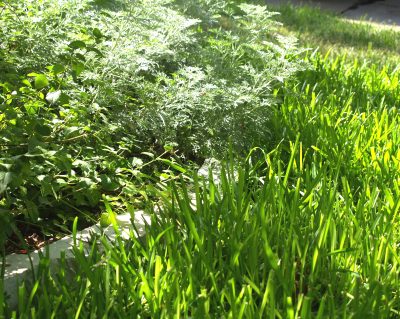Lawn Tips: Reclaiming your Lawn

by Jeff Rodgers
6 ways to save your untamed turf:
- Choose the right soil.If you are lucky enough to have bare soil, start with a good layer of fine compost. The extra nutrients and organic material will improve the health and beauty of your lawn for the rest of its life! Start with ?” to 1″, tilled or mixed into the soil as much as you can stand.
If you are dealing with established turf that is looking a little worse for wear, rent an aerator. Plug aerators work much better than the spike shoes and are worth every penny in the long run. Once you have created a little space in your soil, adding much needed air to the root system, top dress with compost (spread it thinly over your yard). In winter, add as much as ? inch to the entire lawn. In spring or fall, 1/8 inch is plenty. You don’t want to choke out the grass we are trying to save. Rake it in and water it well. Your grass will love you for it.
- Choose the right turf.Spending the extra $20 or $30 per pallet will save you hundreds over the life of your lawn. For sod in sunny areas, I recommend El Toro Zoysia, Sea Isle Paspalum, or Tif Bermuda. They are resistant to most diseases and fungus, and have a great look. Unfortunately, in truly shady areas, you are a bit more limited. St. Augustine will take more shade than most of the available turf in our area, but requires more care. Fescue is another option for shade, but you will be mowing in the cold. Try to convert as much lawn as possible to beds or hardscape in these shady areas. It will significantly lower the need for maintenance and increase the amount of time you get to spend drinking margaritas.
- Mow, Mow, Mow.
Mowing is the best cultural practice we have for controlling weeds and increasing the density of our lawns. In periods of vigorous growth, we should be mowing every week at around 1 ?” to 2 ?” (about 3 or so on your mower height setting), depending on your turf type. Come summer, when the roots need a little more shade, kick it up to 2″ – 3″ (about 4 or 5 on your mower height setting). Once that turf gets long and starts to open up, weed seeds get in and compete for root space. If it goes too long, those weeds will seed, and your little weed problem will become a huge mess. - Weed Control
The best weed control is a healthy lawn. For those few that do get in, spot treat with a pump hand sprayer. Broadcasting with a hose end just wastes treatment, sending it into our waterways, and can harm those plants you want to keep. Stay away from Weed and Feed products. They will hurt your other plants and trees, potentially causing stunted growth and even death. They also have a tendency to fertilize those weeds that they don’t control. REMEMBER: If you are going to spray, spot treat with a hand sprayer. It works better and doesn’t cause so many problems. For an organic that doesn’t burn your lawn, there is always the old “hands and knees” method. - Water right.
Healthy plants need deep roots. Water only a couple of times each week, but water deep. The soil needs to dry out a little between waterings. Too much water for too long limits air in the root system. Grass needs air to move nutrients and take up water. Too little time between waterings just grows fungus like brown patch or take-all patch. To make sure you are watering plenty, get a 100-pack of Dixie cups and spread them around your yard. Look at the clock and water until the cups are 1 ?” full, then stop. Look at the clock again. That is the amount of time you should be watering every three to five days. Remember to take rain into account. - Fertilize right.
With fertilization, less is often more. Any nitrogen not used by your turf gets sent to your weeds and fungus. The newest turf study recommendations say a 2-1-0 ratio is plenty for St. Augustine. Most commonly, you will find a 4-1-2 or 5-1-2 ratio is easiest to find. Check the numbers on the back of the bag. If the nitrogen is 19, the phosphorous is 5, and the potassium is 9, that is basically a 4-1-2 ratio. If the bag is rated for 1000 sq. ft., using it at half rate (covering 2000 sq. ft.) will give you a spread at 10-2.5-5, more than plenty to feed your lawn. For fertilizers, I recommend Milorganite or Ladybug. Both offer great organic fertilizer that your lawn will love.
Another great way to get some organic material into your soil is to top dress with fine compost. This supplement will both fertilize and build healthy soil. Spread at about 1/8″, twice per year. Remember to check your soil height compared to your walks and foundation. If your soil builds up above your sidewalk, it is easy to cut your lawn too short and open up to weeds and stress.
Speaking of stress, it gets a little hot around here come summer. Imagine how you would feel if you were stuck out in the yard all day in August. That is just what is happening to your lawn. To reduce stress on your turf (and all your other plants, too) spray 2-4 times per month with liquid seaweed. This is one of the few treatments you can put in a hose end sprayer and just go crazy with. You will have the best looking landscape on the block all summer long.
Jeff’s varieties for sun:
- El Toro zoysia
- Sea Isle Paspalum
- Tif Bermuda
categories:
tags:
